
Quebec City, officially Québec, is the capital city of the Canadian province of Quebec. As of July 2021, the city had a population of 549,459, and the metropolitan area had a population of 839,311. It is the eleventh-largest city and the seventh-largest metropolitan area in Canada. It is also the second-largest city in the province, after Montreal. It has a humid continental climate with warm summers coupled with cold and snowy winters.
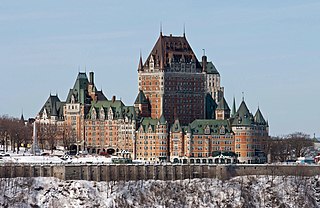
The Fairmont Le Château Frontenac, commonly referred to as the Château Frontenac, is a historic hotel in Quebec City, Quebec, Canada. The hotel is situated in Old Quebec, within the historic district's Upper Town, on the southern side of Place d'Armes. The Château Frontenac was designed by Bruce Price, and was built by the Canadian Pacific Railway company. The hotel is managed by Fairmont Hotels and Resorts.

The City of Brussels is the largest municipality and historical centre of the Brussels-Capital Region, as well as the capital of the Flemish Region and Belgium. The City of Brussels is also the administrative centre of the European Union, as it hosts a number of principal EU institutions in its European Quarter.

Old Montreal is a historic neighbourhood within the municipality of Montreal in the province of Quebec, Canada. Home to the Old Port of Montreal, the neighbourhood is bordered on the west by McGill Street, on the north by Ruelle des Fortifications, on the east by rue Saint-André, and on the south by the Saint Lawrence River. Following recent amendments, the neighbourhood has expanded to include the Rue des Soeurs Grises in the west, Saint Antoine Street in the north, and Saint Hubert Street in the east.
Ville-Émard is a neighbourhood located in the Sud-Ouest borough of Montreal, Quebec, Canada.

Old Quebec is a historic neighbourhood of Quebec City, Quebec, Canada. Comprising the Upper Town and Lower Town, the area is a UNESCO World Heritage Site. Administratively, Old Quebec is part of the Vieux-Québec–Cap-Blanc–colline Parlementaire district in the borough of La Cité-Limoilou.

Le Vieux-Longueuil is a borough in the city of Longueuil.

Peel Street (officially in French: rue Peel) is a major north–south street located in downtown Montreal, Quebec, Canada. The Street links Pine Avenue, near Mount Royal, in the north and Smith Street, in the Southwest borough, in the south. The street's southern end is at the Peel Basin of the Lachine Canal. The street runs through Montreal's shopping district. The Peel Metro station is named for the street.

The Centre-Sud is a neighbourhood located in the easternmost edge of the Ville-Marie borough of the city of Montreal.
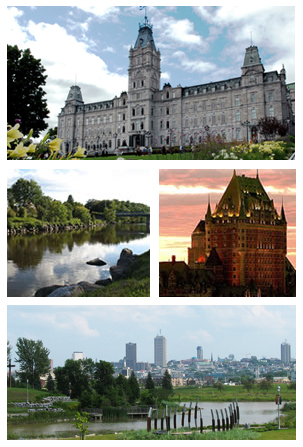
La Cité-Limoilou is the central borough of Quebec City, the oldest, and the most populous, comprising 21.85% of the city's total population. As an administrative division, it is very new, having only been formed on November 1, 2009, from the former boroughs of La Cité and Limoilou.

Quartier du Petit Champlain is a small commercial zone in Quebec City, Quebec, Canada. It is located in the neighbourhood of Vieux-Québec–Cap-Blanc–colline Parlementaire in the borough of La Cité-Limoilou, near Place Royale and its Notre-Dame-des-Victoires Church. Its main street is the Rue du Petit-Champlain at the foot of Cap Diamant. It is claimed that it's the oldest commercial district in North America.

Vieux-Québec–Cap-Blanc–Colline Parlementaire is one of the 35 districts of the City of Quebec, and one of six that are located in the borough of La Cité-Limoilou. The district is the most visited and toured location in the city. It is in this partly fortified area where the Château Frontenac is found, with its large terrace overlooking the city of Lévis, across the Saint Lawrence River. A large concentration of cafes, tourist shops, restaurants, hotels and inns are situated in the district. In its most recent census count in 2016, Statistics Canada reported that the district had a population of 5,770 residents, whom comprise 1.1% of the city's total population.

The Breakneck Stairs, or Breakneck Steps, is Quebec City's oldest stairway, built in 1635. Originally called escalier Champlain, escalier du Quêteux, or escalier de la Basse-Ville, they were given their current name in the mid-19th century, because of their steepness. The stairs, which connect Côte de la Montagne in the "Upper Town" to the corner of Rue du Petit-Champlain and Rue Sous-le-Fort in the "Lower Town"), have been restored several times, including an 1889 renovation by Charles Baillargé, which converted the steps from a single flight into three parallel ones.

Terrasse Dufferin is a boardwalk that wraps around the Château Frontenac in Quebec City, Quebec, towards the Citadelle, overlooking the St. Lawrence River.
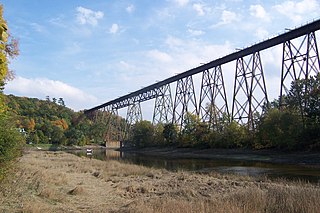
The Cap-Rouge river is a river flowing on the north shore of the Saint-Laurent river at the height of the Sainte-Foy–Sillery–Cap-Rouge borough of Quebec City and in the city of Saint-Augustin-de-Desmaures, both cities in the administrative region of Capitale-Nationale, in the province of Quebec, Canada.

In Quebec City, the term promontory of Quebec refers to the area on which is built the upper part of the borough of La Cité-Limoilou, including Old Quebec. This area covers the eastern half of a larger plateau attested in French as colline or even plate-forme de Québec. The western portion of this plateau is occupied by upper Sainte-Foy–Sillery–Cap-Rouge.
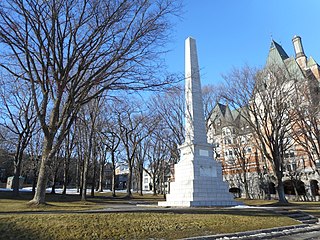
Governors' Garden is an urban park in Quebec City, Quebec, Canada. Designed by Robert Desjardins, the garden is located immediately to the south of Château Frontenac and is bounded by Rue Mont-Carmel to the north, Rue des Carrières to the east, Avenue Sainte-Geneviève to the south, and Rue de la Porte to the west. It is 750 square metres (8,100 sq ft) in area. The park overlooks the St. Lawrence River in the east, beyond Dufferin Terrace.
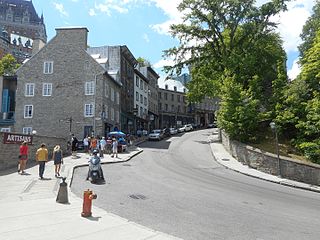
Côte de la Montagne is a street in the Canadian city of Quebec City, Quebec. It climbs, in a winding fashion, Cap Diamant, connecting the Lower Town to the Upper Town. It begins at Rue Dalhousie in the east and ends at Rue Port Dauphine in the west. Directly opposite its western terminus is the building of the Roman Catholic Archdiocese of Quebec.

























